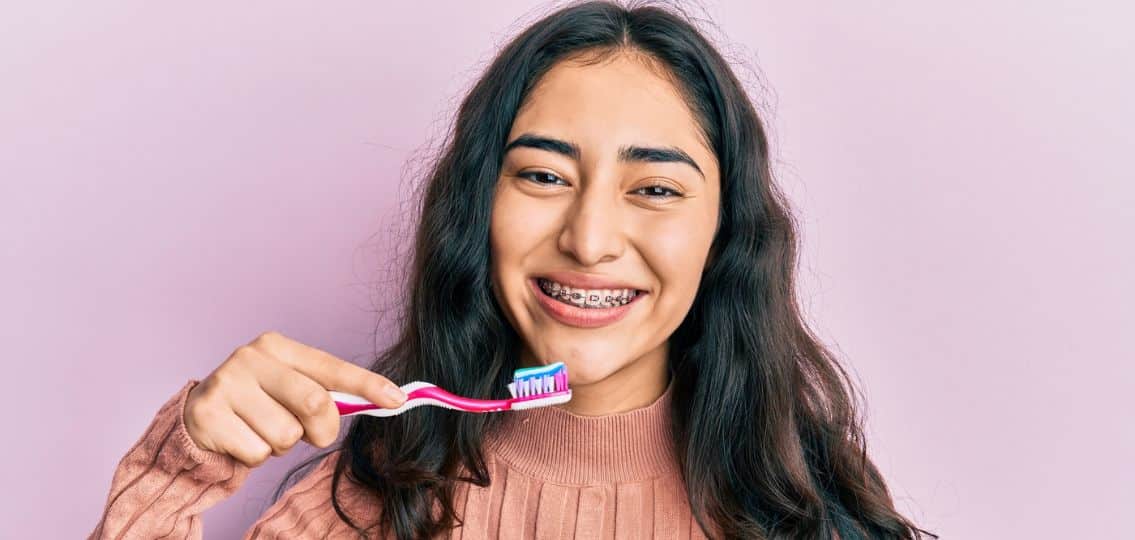
By Kimberly Yavorski
Does your child have an overbite, underbite, crossbite, misaligned teeth, crowding, or other jaw issues? Are you thinking about whether your child should see an orthodontist? Do you wonder what age they need to be for their first appointment? Or, maybe you’re wondering how much treatment will cost? You’ve come to the right place. Your Teen Media spoke with Dr. Philip Bomeli, orthodontist and owner of Solon Orthodontics, to get answers to these questions and more.
What’s the ideal age to see an orthodontist?
The American Association of Orthodontists recommends patients go to an orthodontist for a screening by age seven, which is when kids typically have enough permanent teeth for the orthodontist to spot problems with facial and jawbone growth patterns. Bomeli explains, “At that point in time, based upon what we know about how humans grow, we can detect things that are going awry.”
My kids’ mouth is a mess, and they still have some baby teeth. Does it make sense to go to an orthodontist now, or wait until my kid has all their permanent teeth?
Go now! Even though treatment typically begins between the ages of 9 and 14, Bomeli says early screening can determine if something is going on that warrants earlier treatment.
“There are cases where it makes incredible sense to begin early, even if there are still baby teeth present. If at any point in time you have a concern, the best thing to do is to see an orthodontic professional. They can let you know if there’s definitely something that needs to be done at this point, or, despite what you see, everything’s under control at this point and while your child may need treatment later on in life, maybe it doesn’t make the most sense at this point in time. It depends on the particular situation.”
Bomeli would much rather say, “Hey, things are looking okay for right now…but let’s keep an eye on X, Y or Z,” than have to disappoint patients later with news like “I wish I would’ve seen you two years ago, because at that point in time, I could have done A, B or C to help you. Now it’s a bigger problem.”
How much does orthodontic treatment cost?
That’s a tough question to answer, according to Bomeli, because cost is dependent on so many factors, especially how much treatment a patient needs. Generally, there’s some initial cost as a treatment plan is developed. Later, as a patient matures and their mouth changes, there might be additional costs.
For example, when your child is young, they might need some early interceptive treatment. And then, as they grow older, they might need additional treatment—or, they might not. Materials used can also drive up cost. “Are you using Invisalign or braces? Are you just holding teeth in place with a retainer, or are you entirely dependent on it?” The duration of treatment factors in, as well, as Bomeli explains, “If there’s less need for correction, there’s less treatment involved, and therefore less cost associated with it, proportionally speaking.”
Bomeli’s advice is to go for an evaluation because “cost really is entirely dependent upon what your child needs for their treatment.” Let the orthodontist take a look at your child’s bite so they can better answer that question for you.
Is orthodontic treatment covered by insurance?
Yes, depending on which plan or plans you have. Many of today’s dental/health plans cover at least a portion of orthodontic treatment. Check your policy and be sure to read the fine print, because as Bomeli points out, “there is typically a lifetime maximum on orthodontics, meaning the benefits don’t reset every year.”
“If you still hold the same insurance for a long period of time, and you used it on a child for interceptive treatment when they were younger, you may not have any benefits left for them later on in the second phase of their treatment,” Bomeli warns.
The good news is, if you switch jobs or get a new insurance plan, those maximums reset because you haven’t used that new insurance policy to pay for treatment yet.
Does it hurt to get braces put on your teeth?
Some patients are surprised to find that the process can be pretty relaxing. Bomeli explains that it starts with a cheek and lip stretcher, similar to what’s used in the game Watch Ya’ Mouth. Then the orthodontist places the braces on the teeth.
Soreness kicks in later that evening or over the next couple of days. “Cooler foods—things like ice cream and popsicles—are soothing, like icing a bruise,” he says. “After the first few days, people adapt and are in pretty good shape.” New soreness can occur when patients return for adjustments (approximately every eight weeks), but never to the same level as in those first few days.
Does my kid still need to see their dentist if they already go to the orthodontist?
Regular orthodontic checks are no substitute for routine oral hygiene. It’s important to keep up with your general dentist for cleanings every six months. While dental professionals may collaborate regarding your child’s care, your orthodontist will focus on straightening teeth while your general dentist will check for cavities and other oral issues.
“The mouth’s a pretty harsh environment,” says Bomeli.”There are changes in temperature, changes in saliva, and all kinds of mechanical things happening.” Even though an orthodontist attaches braces and appliances to teeth with strong adhesives, braces do sometimes pop loose from teeth, especially when folks are not careful about what they’re eating. “Really sticky, really hard, and really chewy items can cause a decent amount of damage, as can other habits, like chewing on pens or pencils,” Bomeli points out. “But you don’t have to eliminate foods from your diet.” He says it’s matter of modifying how you prepare and eat those foods. For example, eating apples and large carrots can cause problems if you eat them whole and raw, but you can solve that by cutting them up into smaller pieces or by cooking them.
Anything that makes you think, Gee, this could break something if I eat it, probably shouldn’t be eaten, or at least not in that form.
Can my kid play sports if they have braces or appliances on their teeth? Can they still play their musical instrument?
“Absolutely,” Bomeli says. “We have tons of patients who play sports and play instruments. We don’t want any of that to stop during orthodontic treatment.” The orthodontist will provide your child with a specific mouthguard to prevent soft tissue injuries and keep their teeth safe.
If my kid needs a mouthguard, can they use one from the drugstore shelf?
Using a typical boil-and-bite mouthgard is not a great idea, according to Bomeli. Those types of mouthgards might be fine on day one, but “we’re moving the teeth, so it might not fit a day or week later. We also find the boil-and-bite type of mouthguards adhere too well and can pull braces off or wires out.”
Bomeli says that using a stock mouthguard is a better option, though he admits they may not feel comfortable at first. “They’re going to be slightly bulkier than your kids are used to because now they have to fit between braces and lips, as opposed to simply between teeth and your lips. We’re only talking a couple of millimeters, but in the world of mouths, that might feel like a mile. There’s an adjustment period, but people adapt to them pretty quickly. And your kids can adapt again once they get their braces off.”
Is it possible to remove my kid’s braces temporarily, like say if we have a special family occasion or an event?
According to Bomeli, people often ask to have braces removed temporarily, especially before a wedding, and he can accomodate those requests. He says, “It’s an extra couple of appointments to take the braces off and put them back on. And there’s some extra costs associated with that.” He also reminds patients that there’s another option: they can digitally remove braces and appliances in their photos.
Are there options to speed up orthodontic treatment?
There is a whole body of research done to see whether specific equipment results in faster treatment. Bomeli says that techniques in development may shave a couple of months off treatment “but the clinical significance is pretty minimal. And some techniques that involve surgical intervention might accelerate tooth movement for a short period of time, but those are pretty extensive and costly. At the end of the day, it’s applying forces to teeth and moving the teeth and the roots through bone and gum tissue. And that just takes time.”

 PARENTING TIPS
PARENTING TIPS PREGNANCY
PREGNANCY BABY CARE
BABY CARE TODDLERS
TODDLERS TEENS
TEENS HEALTH CARE
HEALTH CARE ACTIVITIES & CRAFTS
ACTIVITIES & CRAFTS

